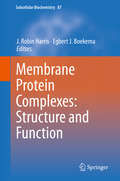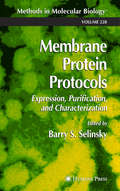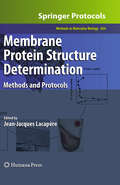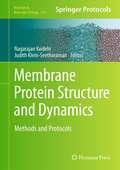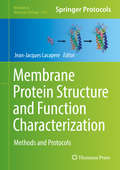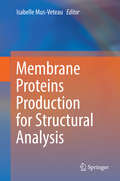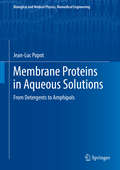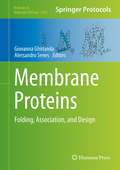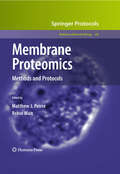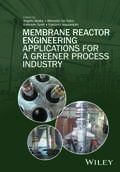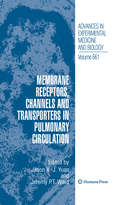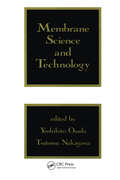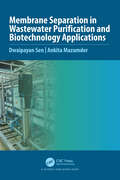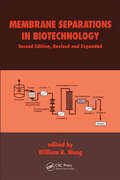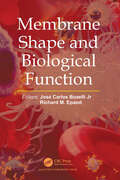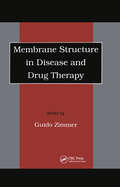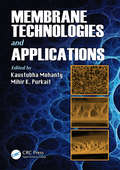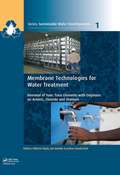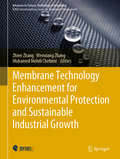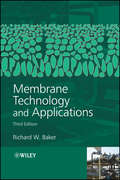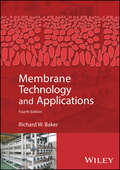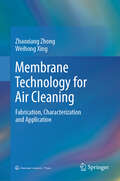- Table View
- List View
Membrane Protein Complexes: Structure and Function (Subcellular Biochemistry #87)
by J. Robin Harris Egbert J. BoekemaThis edited book contains a compilation of 14 advanced academic chapters dealing with the structure and function of membrane protein complexes. This rapidly advancing important field of study closely parallels those on soluble protein complexes, and viral protein and nucleoprotein complexes. Diverse topics are included in this book, ranging from membrane–bound enzymes to ion channels, proton pumps and photosystems. Data from X-ray crystallography, cryo-electron microscopy and other biophysical and biochemical techniques are presented throughout the book. There is extensive use of colour figures of protein structures. Throughout the book structure and function are closely correlated. The two editors, Egbert Boekema and J. Robin Harris, have worked on aspects of membrane and soluble proteins throughout their scientific careers and also have much publishing experience. The Subcellular Biochemistry series has expanded considerably in recent years, including several related volumes. The theme of protein complexes will be continued within several future volumes, thereby creating encyclopaedic coverage. The chapter topics within this book are particularly relevant to those involved in the biological and biomedical sciences. It is aimed at the advanced undergraduates, postgraduates and established researchers within this broad field. It is hoped that the book will be of interest and use to those involved with the study of cellular membranes and their associated proteins.
Membrane Protein Protocols
by Barry S. SelinskyA collection of key techniques for the study of receptors and transport proteins. The book provides examples of how different membrane proteins can be overexpressed in both prokaryotic and eukaryotic expression systems, how natural and overexpressed proteins can be solubilized from their host membranes, and how the solubilized protein can be purified in active form. Each protocols contains step-by-step instructions to ensure success, troubleshooting advice, lists of reagents, and tips on avoiding pitfalls.
Membrane Protein Structure Determination
by Jean-Jacques LacapèreMembrane proteins, representing nearly 40% of all proteins, are key components of cells involved in many cellular processes, yet only a small number of their structures have been determined. Membrane Protein Structure Determination: Methods and Protocols presents many detailed techniques for membrane protein structure determination used today by bringing together contributions from top experts in the field. Divided into five convenient sections, the book covers various strategies to purify membrane proteins, approaches to get three dimensional crystals and solve the structure by x-ray diffraction, possibilities to gain structural information for a membrane protein using electron microscopy observations, recent advances in nuclear magnetic resonance (NMR), and molecular modelling strategies that can be used either to get membrane protein structures or to move from atomic structure to a dynamic understanding of a molecular functioning mechanism. Written in the highly successful Methods in Molecular BiologyTM series format, chapters include introductions to their respective topics, lists of the necessary materials and reagents, step-by-step, readily reproducible laboratory protocols, and tips on troubleshooting and avoiding known pitfalls. Comprehensive and easy to use, Membrane Protein Structure Determination: Methods and Protocols serves as an ideal reference for scientists seeking to further our knowledge of these vital and versatile proteins as well as our overall understanding of the complicated world of cell biology.
Membrane Protein Structure and Dynamics
by Nagarajan Vaidehi Judith Klein-SeetharamanMembrane proteins play key roles in numerous cellular processes, in particular mediating cell-to-cell communication and signaling events that lead to a multitude of biological effects. Membrane proteins have also been implicated in many critical diseases such as atherosclerosis, hypertension, diabetes and cancer. In Membrane Protein Structure Predictions Methods: Methods and Protocols, expert researcher in the field detail the advances in both experimental and computational approaches of the structure, dynamics and interactions of membrane proteins dividing the volume into two sections. The first section details the procedures used for measurements of structure and dynamics of membrane proteins. While the second section contains a survey of the computational methods that have played a critical role in membrane protein structure prediction as well as in providing atomic level insight into the mechanism of the dynamics of membrane receptors. Written in the highly successful Methods in Molecular BiologyTM series format, the chapters include the kind of detailed description and implementation advice that is crucial for getting optimal results in the laboratory. Thorough and intuitive, Membrane Protein Structure Predicitons: Methods and Protocols seeks to aid scientists in the further study of membrane protein structure and function.
Membrane Protein Structure and Function Characterization
by Jean-Jacques LacapereIn this present volume, different approaches are detailed to produce membrane proteins, purify them, study their function, determine their structure, and model them in membrane. Since every membrane protein behaves mostly in a unique way /fashion, knowledge of guidelines and tricks may help to increase chances to express, purify and characterize a peculiar membrane protein. Production of correctly folded protein remains a challenge. Moreover, getting a functional and stable protein requires to optimize membrane mimicking environments that can be detergent or artificial membranes. In some cases, the finding of the correct ligand which will stabilize the desired conformation is needed. In other cases, stabilization can be obtained using specific antibodies. This volume also presents different techniques to analyze the functional status of membrane proteins. Written in the highly successful Methods in Molecular Biology series format, chapters in Membrane Protein Structure and Function Characterization: Methods and Protocols provide different techniques to analyze the functional and structural status of membrane proteins. Chapters include introductions to their respective topics, lists of the necessary materials and reagents, step-by-step, readily reproducible laboratory protocols, and tips on troubleshooting and avoiding known pitfalls. Authoritative and practical, Membrane Protein Structure and Function Characterization: Methods and Protocols aims to ensure successful results in the further study of this vital field.
Membrane Proteins Production for Structural Analysis
by Isabelle Mus-VeteauThis book updates the latest development in production, stabilization and structural analysis techniques of membrane proteins. This field has made significant advances since the elucidation of the first 3-D structure of a recombinant G Protein Coupled Receptor (GPCR), rhodopsin, with the structure of several more GPCRs having been solved in the past five years. In fact, the 2012 Nobel Prize in Chemistry was awarded for groundbreaking discoveries on the inner workings of GPCRs. This book is essential reading for all researchers, biochemists and crystallographers working with membrane proteins, who are interested by the structural characterization of their favorite protein and who wish to follow the expression, migration, modifications and recycling of a membrane protein.
Membrane Proteins in Aqueous Solutions: From Detergents to Amphipols (Biological and Medical Physics, Biomedical Engineering)
by Jean-Luc PopotThis book is the first to be entirely devoted to the challenging art of handling membrane proteins out of their natural environment, a key process in biological and pharmaceutical research, but one plagued with difficulties and pitfalls. Written by one of the foremost experts in the field, Membrane Proteins in Aqueous Solutions is accessible to any member of a membrane biology laboratory. After presenting the structure, functions, dynamics, synthesis, natural environment and lipid interactions of membrane proteins, the author discusses the principles of extracting them with detergents, the mechanisms of detergent-induced destabilization, countermeasures, and recent progress in developing detergents with weaker denaturing properties. Non-conventional alternatives to detergents, including bicelles, nanodiscs, amphipathic peptides, fluorinated surfactants and amphipols, are described, and their relative advantages and drawbacks are compared. The synthesis and solution properties of the various types of amphipols are presented, as well as the formation and properties of membrane protein/amphipol complexes and the transfer of amphipol-trapped proteins to detergents, nanodiscs, lipidic mesophases, or living cells. The final chapters of the book deal with applications: membrane protein in vitro folding and cell-free expression, solution studies, NMR, crystallography, electron microscopy, mass spectrometry, amphipol-mediated immobilization of membrane proteins, and biomedical applications. Important features of the book include introductory sections describing foundations as well as the state-of-the-art for each of the biophysical techniques discussed, and topical tables which organize a widely dispersed literature. Boxes and annexes throughout the book explain technical aspects, and twelve detailed experimental protocols, ranging from in vitro folding of membrane proteins to single-particle electron cryomicroscopy, have been contributed by and commented on by experienced users. Membrane Proteins in Aqueous Solutions offers a concise, accessible introduction to membrane protein biochemistry and biophysics, as well as comprehensive coverage of the properties and uses of conventional and non-conventional surfactants. It will be useful both in basic and applied research laboratories and as a teaching aid for students, instructors, researchers, and professionals within the field.
Membrane Proteins: Folding, Association, and Design
by Giovanna Ghirlanda Alessandro SenesFocusing on model systems for the study of structure, folding, and association in the membrane, Membrane Proteins: Folding, Association, and Design presents an overview of methods that can be applied to these intricate systems. The volume is divided into four detailed sections, covering association of transmembrane helices, interactions with the lipid bilayer, NMR methods, as well as a variety of engineering approaches. Written for the highly successful Methods in Molecular Biology series, chapters include introductions to their respective topics, lists of the necessary materials and reagents, step-by-step, readily reproducible laboratory protocols, and tips on troubleshooting and avoiding known pitfalls. Authoritative and practical, Membrane Proteins: Folding, Association, and Design serves as an ideal guide for researchers reaching for the tantalizing possibility of designing novel membrane proteins with tailored functionality.
Membrane Proteomics
by Matthew J. Peirce Robin WaitWith the great cellular and therapeutic importance of plasma membrane proteins, unbiased technologies such as proteomics become even more vital as they have the power to define patterns of membrane protein expression characteristic of distinct states of cellular development, differentiation or disease, and thereby identify novel markers of, or targets for intervention in, disease. In Membrane Proteomics: Methods and Protocols, leading experts in the field compile a laboratory bench resource which provides a comprehensive toolkit of proven methods. The volume delves into various modifications to standard two-dimensional gel electrophoresis protocols as well as liquid chromatographic methods, protocols for the enrichment of diverse classes of plasma membrane proteins, in silico approaches, and cutting-edge techniques for quantitative membrane protein profiling. Written in the highly successful Methods in Molecular BiologyTM series format, chapters include brief introductions to their respective topics, lists of the necessary materials and reagents, step-by-step, readily reproducible laboratory protocols, and notes on troubleshooting and avoiding known pitfalls. Comprehensive and easy-to-use, Membrane Proteomics: Methods and Protocols is an ideal guide for investigators wishing to apply state of the art membrane proteomic methodologies in their own research programs.
Membrane Reactor Engineering: Applications for a greener process industry
by Gaetano Iaquaniello Marcello De Falco Angelo Basile Gabriele CentiUniquely focussed on the engineering aspects of membrane reactors Provides tools for analysis with specific regard to sustainability Applications include water treatment, wastewater recycling, desalination, biorefineries, agro-food production Membrane reactors can bring energy saving, reduced environmental impact and lower operating costs
Membrane Reactors for Hydrogen Production Processes
by Gaetano Iaquaniello Marcello De Falco Luigi MarrelliMembrane Reactors for Hydrogen Production Processes deals with technological and economic aspects of hydrogen selective membranes application in hydrogen production chemical processes. Membrane Reactors for Hydrogen Production Processes starts with an overview of membrane integration in the chemical reaction environment, formulating the thermodynamics and kinetics of membrane reactors and assessing the performance of different process architectures. Then, the state of the art of hydrogen selective membranes, membrane manufacturing processes and the mathematical modeling of membrane reactors are discussed. A review of the most useful applications from an industrial point of view is given. These applications include: natural gas steam reforming,autothermal reforming,water gas shift reaction,decomposition of hydrogen sulphide, andalkanes dehydrogenation.The final part is dedicated to the description of a pilot plant where the novel configuration was implemented at a semi-industrial scale. Plant engineers, researchers and postgraduate students will find Membrane Reactors for Hydrogen Production Processes a comprehensive guide to the state of the art of membrane reactor technology.
Membrane Receptors, Channels and Transporters in Pulmonary Circulation
by Jason X. Yuan Jeremy P. WardMembrane Receptors, Channels and Transporters in Pulmonary Circulation is a proceeding of the 2008 Grover Conference (Lost Valley Ranch and Conference Center, Sedalia, Colorado; September 3-7, 2008), which provided a forum for experts in the fields of those receptors, channels and transporters that have been identified as playing key roles in the physiology and pathophysiology of the pulmonary circulation. The book rigorously addresses: i) recent advances in our knowledge of receptors, channels and transporters and their role in regulation of pulmonary vascular function; ii) how modulation of expression and function of receptors, channels and transporters and their interrelationships contribute to the pathogenesis of pulmonary vascular disease; and iii) the therapeutic opportunities that may be revealed by enhancing our understanding of this area. The overall goal was to explore the mechanisms by which specific receptors, channels and transporters contribute to pulmonary vascular function in both health and disease, and how this knowledge may lead to novel interventions in lung dysplasia, pulmonary edema, lung injury, and pulmonary and systemic hypertension to reduce and prevent death from lung disease. Membrane Receptors, Channels and Transporters in Pulmonary Circulation is divided into six parts. Part 1 (Ion Channels in the Pulmonary Vasculature: Basics and New Findings) is designated for basic knowledge and recent findings in the research field of ion channels in pulmonary circulation. There are five chapters in Part I discussing the function, expression, distribution and regulation of various ion channels present in pulmonary vascular smooth muscle cells and how these channels are integrated to regulate intracellular Ca2+ and cell functions. Part II (TRP Channels in the Pulmonary Vasculature: Basics and New Findings) is composed of five chapters that are exclusively designed to discuss the role of a recently identified family of cation channels, transient receptor potential (TRP) channels, in the regulation of pulmonary vascular tone and arterial structure. Part III (Pathogenic Role of Ion Channels in Pulmonary Vascular Disease) includes four chapters that discuss how abnormal function and expression of various ion channels contribute to changes in cell functions and the development of pulmonary hypertension. Part IV (Receptors and Signaling Cascades in Pulmonary Arterial Hypertension) consists of five chapters devoted to the role of bone morphogenetic protein receptors, Notch receptors, serotonin receptors, Rho kinase and vascular endothelial growth factor receptors in the development of pulmonary arterial hypertension. Part V (Receptors and Transporters: Role in Cell Function and Hypoxic Pulmonary Vasoconstriction) includes four chapters designed to illustrate the potential mechanisms involved in oxygen sensing and hypoxia-induced pulmonary vasoconstriction and hypertension. Part VI (Targeting Ion Channels and Membrane Receptors in Developing Novel Therapeutic Approaches for Pulmonary Vascular Disease) consists five chapters which discuss the translational research involving on membrane receptors, channels and transporters, including their potential as novel drug targets. We hope that Membrane Receptors, Channels and Transporters in Pulmonary Circulation will allow readers to foster new concepts and new collaborations and cooperations among investigators so as to further understand the role of receptors, channels and transporters in lung pathophysiology. The ultimate goal is to identify new mechanisms of disease, as well as new therapeutic targets for pulmonary vascular diseases. An additional outcome should be enhanced understanding of the role of these entities in systemic vascular pathophysiology, since the conference will include researchers and clinicians with interests in both pulmonary and systemic circulations.
Membrane Science and Technology
by Yoshihito Osada Tsutomu NakagawaThis volume covers the theory and applications of transport phenomena in synthetic membranes - describing modern membrane preparation methods, structures, characteristics and properties.;Examining different types of membranes and how they are used, Membrane Science and Technology: presents the physical and chemical fundamentals of membrane science;
Membrane Separation in Wastewater Purification and Biotechnology Application
by Dwaipayan Sen Ankita MazumderThe book addresses fundamental principles of the membrane separation technology along with an insight of the modern membrane separation process. Conventional membrane processes are discussed in several books advanced membrane separation processes like ionexchange membrane separation etc. are fragmentally discussed in several scientific journals and patents. Therefore, here the discussion is made on most advanced membrane applications from sensing biomarkers to tissue engineering along with different case studies. It will benefit heterogeneous audience including practitioners, process engineers, researchers and students from chemical engineering, biochemical engineering, and environmental engineering. The most interesting feature that may attract is the inclusion of machine learning in predicting and designing the membrane processes. This book can be referred by someone who wishes to learn about the fundamental principles and a general area of application along with scholars seeking more detailed information about the recent advancement in membrane separation technologies.
Membrane Separation of Food Bioactive Ingredients (Food Bioactive Ingredients)
by Seid Mahdi Jafari Roberto Castro-MuñozThis book covers current developments in membrane-based technologies for the successful recovery of food bioactive ingredients and molecules. Chapters explore emerging technologies, such as microfiltration, ultrafiltration, nanofiltration, and membrane distillation, for the selective concentration and food ingredients from food by-products, as well as techniques, such as pervaporation, for the selective separation and recovery of aroma compounds. The text provides one of the first examinations of other membrane-based technologies, such as liquid membranes (microemulsions), membrane distillation (MD) and pervaporation (PV), as thermal driven membrane processes. The separation of metabolites from microalgae and fermentation broths using membrane technologies is also covered. Researchers in food science, pharmaceutics and biotechnology looking to stay up-to-date on bioactive recovery, as well as membranologists exploring new applications for membrane-based technologies, will find this text a useful resource.
Membrane Separations in Biotechnology
by Wiliam K. WangThis text details the relationship between membrane technology and bioprocesses, discussing applications. This second edition refines and optimizes key features of the first edition - and features new illustrative case studies. The book examines advantages and disadvantages of using standard and new membrane technologies; analyzes a wide range of a
Membrane Shape and Biological Function
by Richard M. Epand José Carlos BozelliMembrane Shape and Biological Function is an important guide for anyone interested in the dynamic world of biological membranes. The book explores how membrane shape influences crucial biological processes and highlights its practical applications. It delves into the mechanics of lipid bilayers, their role in cellular processes, and computational methods for understanding membrane remodeling, including real-world applications such as the Golgi apparatus' structure and function, the role of inositol phospholipids in cellular organization, membrane fusion in cell biology, and the potential of lipid bilayers in neuromorphic computing. This comprehensive resource is valuable for students, researchers, and anyone curious about membrane biology.
Membrane Structural Biology
by Mary LuckeyMembrane Structural Biology brings together a physicochemical analysis of the membrane with the latest structural biology on membrane lipids and proteins to offer an exciting portrayal of biomembranes. Written with remarkable clarity, this text appears at a time when membranes have moved back into the scientific spotlight and will provide a unique foundation for advanced students and working scientists. The structure, function and biogenesis of membrane lipids and proteins are examined, bioinformatics and computational approaches to membrane components are introduced, and the high-resolution structures that are giving new insights into the vital roles membranes play are discussed. The many correlations between membrane research and human health are discussed and key themes for future work in this area are identified. Membrane structural biology is poised to answer many basic and applied questions and this cutting-edge text will provide a solid grounding for all those working in this field.
Membrane Structure in Disease and Drug Therapy
by Svante CornellThis study asserts that cellular and intracellular membranes are active in every aspect of the body's physiology and pathophysiology. It compares secondary through to quaternary structures and protien sequences and guages their influence on health, disease and drug therapy. The book highlights the importance of correlations, homologies and categori
Membrane Technologies and Applications
by Mihir K. Purkait Kaustubha MohantyCompiling recent advances in membrane separations technology, this highly relevant book introduces cost-effective solutions for separation problems in a wide range of industries. It discusses membrane use in water and wastewater treatment; food and dairy industry and fuel cell applications. It describes the role of membrane technologies in resource recovery, pollution prevention, and energy production, as well as environmental monitoring and quality control. A concise resource for emerging technologies, this book provides the tools to implement effective production processes, improve environmental protection and public health, and explore new opportunities for the industry.
Membrane Technologies for Water Treatment: Removal of Toxic Trace Elements with Emphasis on Arsenic, Fluoride and Uranium (Sustainable Water Developments - Resources, Management, Treatment, Efficiency and Reuse #1)
by Jan Hoinkis Alberto Figoli Jochen BundschuhFocuses on the application of membrane technologies in removing toxic metals\metalloids from water. Particular attention is devoted to the removal of arsenic, uranium, and fluoride. These compounds are all existing in the earth’s crust at levels between two and five thousands micrograms per kg (parts per million) on average and these compounds can be considered highly toxic to humans, who are exposed to them primarily from air, food and water. In order to comply with the new maximum contaminant level, numerous studies have been undertaken to improve established treatments or to develop novel treatment technologies for removing toxic metals from contaminated surface and groundwater. Among the technologies available, applicable for water treatment, membrane technology has been identified as a promising technology to remove such toxic metals from water. The book describes both pressure driven (traditional processes, such as Nanofiltration, Reverse Osmosis, Ultrafiltration,etc) and more advanced membrane processes (such as forward osmosis, membrane distillation, and membrane bio-reactors) employed in the application of interest. Key aspect of this book is to provide information on both the basics of membrane technologies and on the results depending on the type of technology employed.
Membrane Technology Enhancement for Environmental Protection and Sustainable Industrial Growth (Advances in Science, Technology & Innovation)
by Mohamed Mehdi Chehimi Zhien Zhang Wenxiang ZhangThis book presents a detailed discussion of the fundamentals and practical applications of membrane technology enhancement in a range of industrial processes, energy recovery, and resource recycling. To date, most books on the applications of membrane technology have mainly focused on gas pollution removal or industrial wastewater treatment. In contrast, the enhancement of various membrane processes in the areas of energy and the environment has remained largely overlooked. This book highlights recent works and industrial products using membrane technology, while also discussing experiments and modeling studies on the membrane enhancement process.
Membrane Technology and Applications
by Richard W. Baker"... the best handbook on membrane technology, which is currently on the market... " -Membrane News (on the previous edition)Building on the success of the previous edition, Membrane Technology and Applications Third Edition provides a comprehensive overview of separation membranes, their manufacture and their applications. Beginning with a series of general chapters on membrane preparation, transport theory and concentration polarization, the book then surveys several major areas of membrane application in separate chapters. Written in a readily accessible style, each chapter covers its membrane subject thoroughly, from historical and theoretical backgrounds through to current and potential applications. Topics include reverse osmosis, ultrafiltration, pervaporation, microfiltration, gas separation and coupled and facilitated transport; chapters on electrodialysis and medical applications round out the coverage.NEW TO THE THIRD EDITIONNew sections on the use of membranes in the chlor-alkali industry, membrane distillation, pressure retarded osmosis and constant flux-variable pressure ultrafiltrationZeolite and ceramic membranes, submerged membrane modules, and fuel cell membranesSubstantially enhanced chapters on ultrafiltration, pervaporation and membrane contactorsUpdates to every chapter to reflect the developments in the field
Membrane Technology and Applications
by Richard W. BakerMembrane Technology and Applications Internationally acknowledged text on separation membrane technology, presenting current theory and practice, plus manufacturing and applications The 4th Edition of Membrane Technology and Applications presents an authoritative, up-to-date overview of separation membranes, their theoretical underpinnings, manufacture, and use, beginning with a series of general chapters on membrane preparation, transport theory, and concentration polarization, then surveying the major areas of membrane application in separate chapters. Written in a readily accessible style, each chapter offers a thorough treatment of its subject, from historical and theoretical backgrounds through to current and potential applications. Topics include reverse osmosis, ultrafiltration, microfiltration, gas separation, pervaporation, electrodialysis, coupled and facilitated transport, and medical applications of membranes. This new edition has been comprehensively updated, with substantial new material, figures, and references throughout to reflect the latest developments in the field. Major changes include: A new chapter on transport mechanisms in finely microporous membranes, with focus on gas transport A new chapter on membrane contactors A substantially expanded section on hyperfiltration applications, including pharmaceutical applications, in the reverse osmosis chapter Expanded treatment of membrane bioreactors, plus a new section on biotechnology applications, in the ultrafiltration chapter A new section in the gas separation chapter devoted to carbon dioxide capture from industrial process emissions, including power plant emissions Research areas that the author would work on if he were, once again, a 21-year-old graduate student. Written by a leading expert with 50 years of experience, Membrane Technology and Applications provides balanced coverage of all aspects of the field, and is essential reading for all membrane enthusiasts, from neophyte graduate student to academic researcher to seasoned industry professional.
Membrane Technology for Air Cleaning: Fabrication, Characterization and Application
by Zhaoxiang Zhong Weihong XingThis book highlights a comprehensive and systematic introduction to the science and technology of gas cleaning membranes. Starting from basic concepts and principles, the book covers the preparation methods, performance parameters, and advances in applications of different types of membrane materials. Industrial smoke and dust emissions are one of the main causes of atmospheric haze. How to strictly control the emission of ultrafine dust and achieve efficient and clean utilization of resources is a common problem faced by industries related to chemical engineering, energy, steel, metallurgy, and building materials. There is an urgent need for new separation technologies. The low efficiency of traditional dust removal technologies cannot meet increasingly strict emission requirements. Membrane technologies provide an effective approach for PM2.5 control with its high separation efficiency and low energy consumption. Especially for the purification of high-temperature gases, it can maximize the utilization of the physical sensible heat of the gas and achieve energy recovery. This book first introduces relevant concepts and terms, separation principles, structure characterization, and evaluation methods of gas cleaning membranes. According to the characteristics of application environments, the preparation methods, performance parameters and application progress of different types of membrane materials, including those for medium and low temperature gases, high temperature gases as well as multi-functional membranes, are described in detail. Relevant equipment and typical application cases in indoor air purification, medical, and industrial fields are discussed. The book also summarizes latest theoretical research frontiers and projects future development trends in this field. This book can be used as a valuable reference for undergraduate and graduate students in materials science, chemical engineering, environmental engineering and researchers engaged in the development of air filtration materials and gas purification technology. The English translation of this book, originally in Chinese, was facilitated by artificial intelligence. The content was later revised by the author for accuracy.
